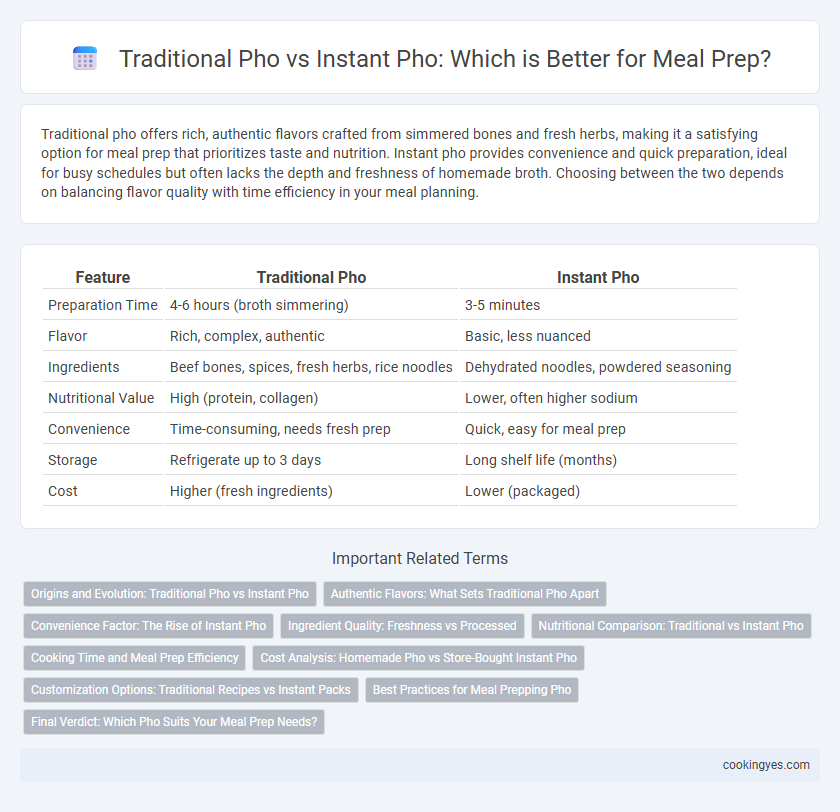Traditional pho offers rich, authentic flavors crafted from simmered bones and fresh herbs, making it a satisfying option for meal prep that prioritizes taste and nutrition. Instant pho provides convenience and quick preparation, ideal for busy schedules but often lacks the depth and freshness of homemade broth. Choosing between the two depends on balancing flavor quality with time efficiency in your meal planning.
Table of Comparison
| Feature | Traditional Pho | Instant Pho |
|---|---|---|
| Preparation Time | 4-6 hours (broth simmering) | 3-5 minutes |
| Flavor | Rich, complex, authentic | Basic, less nuanced |
| Ingredients | Beef bones, spices, fresh herbs, rice noodles | Dehydrated noodles, powdered seasoning |
| Nutritional Value | High (protein, collagen) | Lower, often higher sodium |
| Convenience | Time-consuming, needs fresh prep | Quick, easy for meal prep |
| Storage | Refrigerate up to 3 days | Long shelf life (months) |
| Cost | Higher (fresh ingredients) | Lower (packaged) |
Origins and Evolution: Traditional Pho vs Instant Pho
Traditional pho, originating from Northern Vietnam in the early 20th century, features a slow-cooked beef or chicken broth simmered with spices like star anise and cinnamon, reflecting its rich cultural heritage. Instant pho, developed to meet modern convenience demands, offers a quick, dehydrated version that sacrifices the deep, complex flavors and textures of the original slow-cooked broth. While traditional pho emphasizes authenticity and culinary craftsmanship, instant pho prioritizes speed and shelf stability, marking a significant evolution in how this iconic dish is consumed globally.
Authentic Flavors: What Sets Traditional Pho Apart
Traditional pho boasts a rich, slow-simmered broth infused with fragrant spices like star anise, cinnamon, and cloves, delivering depth and complexity unmatched by instant pho. Fresh herbs, high-quality beef or chicken cuts, and hand-pulled rice noodles contribute to the authentic taste and texture that preserve Vietnamese culinary heritage. Instant pho often relies on powdered broth and preservatives, sacrificing the vibrant aroma and nuanced flavors that define traditional pho's genuine dining experience.
Convenience Factor: The Rise of Instant Pho
Instant pho offers unparalleled convenience for meal prep with its quick cooking time and minimal clean-up, making it ideal for busy lifestyles. Traditional pho requires hours of simmering bones and fresh ingredients, providing richer flavor but less practicality for weeknight meals. The rise of instant pho reflects consumer demand for fast, easy, and portable options without sacrificing the essence of Vietnamese cuisine.
Ingredient Quality: Freshness vs Processed
Traditional pho uses fresh ingredients like aromatic herbs, high-quality beef or chicken, and bone broth simmered for hours, ensuring rich flavor and nutritional value. Instant pho relies on processed components such as dehydrated vegetables, powdered broth, and preservatives, compromising freshness and authentic taste. Choosing traditional pho enhances meal prep with superior ingredient quality and natural nutrients.
Nutritional Comparison: Traditional vs Instant Pho
Traditional pho offers a richer nutrient profile with fresh herbs, lean beef or chicken, and bone broth packed with collagen, vitamins, and minerals supporting joint and gut health. Instant pho often contains higher sodium levels, preservatives, and fewer fresh ingredients, leading to lower overall nutritional value and potential adverse effects on blood pressure. Choosing traditional pho enhances protein intake, antioxidants, and essential micronutrients critical for balanced meal prep and sustained energy.
Cooking Time and Meal Prep Efficiency
Traditional pho requires hours of simmering beef bones and aromatic spices to develop its rich, complex broth, making it less practical for quick meal prep. Instant pho offers significant time savings with pre-cooked noodles and powdered seasoning, allowing meals to be prepared in minutes without sacrificing basic flavors. For efficient meal prep, instant pho provides convenience and speed, while traditional pho delivers superior depth and quality, ideal for leisurely cooking sessions.
Cost Analysis: Homemade Pho vs Store-Bought Instant Pho
Homemade traditional pho requires an initial investment in ingredients like beef bones, spices, rice noodles, and fresh herbs but offers multiple servings that significantly reduce the per-meal cost over time. In contrast, store-bought instant pho typically costs more per serving due to convenience, packaging, and single-use portions, making it less economical for frequent meal prep. Factoring in nutritional quality and portion control, homemade pho presents a more cost-effective and customizable option for budget-conscious individuals committed to authentic flavors.
Customization Options: Traditional Recipes vs Instant Packs
Traditional pho offers extensive customization options, allowing adjustments to broth richness, noodle texture, and fresh herbs, tailoring each bowl to personal taste. Instant pho packs provide convenience but often have limited customization, fixed flavor profiles, and pre-measured ingredients that restrict ingredient substitutions. Meal prep with traditional pho enables creative adaptation for dietary preferences, whereas instant packs prioritize speed over personalized flavor variations.
Best Practices for Meal Prepping Pho
Traditional pho offers rich, complex flavors from slow-simmered beef bones and fresh herbs, making it ideal for meal prepping when time allows. Instant pho provides convenience and speed but often lacks the depth and freshness that enhance long-term storage and reheating quality. Best practices for meal prepping pho include preparing broth in bulk, storing noodles separately to prevent sogginess, and garnishing fresh herbs and lime just before serving to maintain flavor and texture.
Final Verdict: Which Pho Suits Your Meal Prep Needs?
Traditional pho offers rich, authentic flavors and fresh ingredients ideal for those prioritizing taste and quality in meal prep, though it requires longer preparation time. Instant pho provides convenience and quick cooking, making it suitable for busy schedules but often lacks the depth of broth and texture found in traditional recipes. For meal prep, choosing between traditional and instant pho depends on balancing flavor preferences with time constraints and nutritional goals.
Traditional pho vs instant pho for meal prep Infographic

 cookingyes.com
cookingyes.com